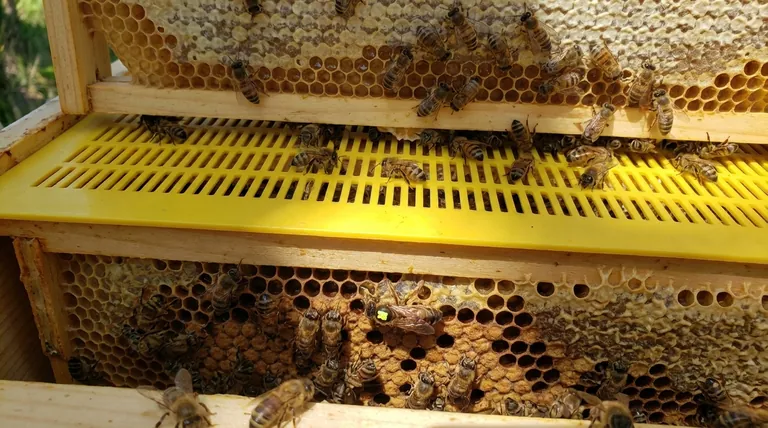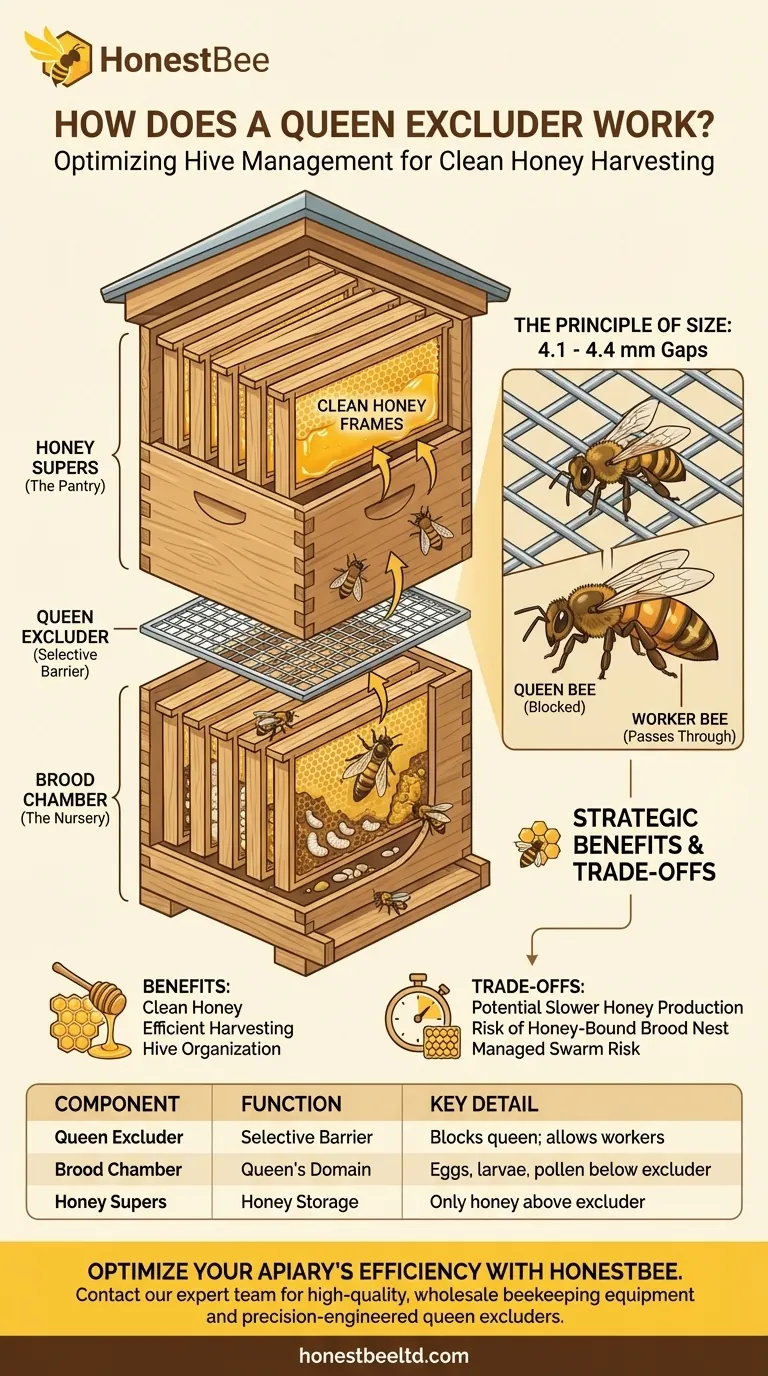At its core, a queen excluder operates on a simple principle of physical size. It is a selective barrier, typically a metal or plastic grid, with gaps precisely engineered to be large enough for worker bees to pass through but too small for the larger queen bee. This simple mechanism allows beekeepers to control exactly where the queen can lay her eggs.
The true purpose of a queen excluder is not merely to block the queen, but to strategically manage the hive's internal structure. It creates a clear separation between the "nursery" (the brood chamber) and the "pantry" (the honey supers), which dramatically simplifies honey harvesting.

The Fundamental Principle: A Matter of Size
A queen excluder works by exploiting the distinct anatomical differences between the types of bees within a colony. The entire system hinges on a measurement of just over 4 millimeters.
The Worker Bee's Passage
Worker bees are the smallest adult bees in the hive. The gaps in a standard queen excluder, typically between 4.1 and 4.4 millimeters, are wide enough for them to pass through without issue.
This allows workers to move freely between the lower parts of the hive and the upper honey storage boxes, known as supers.
The Queen's Confinement
The queen bee is significantly larger than a worker, specifically in her thorax. This larger body size makes it physically impossible for her to squeeze through the excluder's gaps.
By placing the excluder above the boxes designated for brood-rearing, the beekeeper effectively confines the queen to that specific area, preventing her from laying eggs higher up in the hive.
An Unintended Barrier for Drones
Drones, the male bees in the colony, are also larger than worker bees. Consequently, they are also blocked by the excluder and confined to the same area as the queen.
The Strategic Goal: Separating Brood from Honey
Using an excluder is a deliberate management decision designed to make a beekeeper's work more efficient. It forces a clear organization upon the colony's natural tendencies.
Defining the Brood Chamber
The boxes below the excluder become the brood chamber. This is the heart of the colony, where the queen lays her eggs and the workers raise the next generation of bees.
This area will contain a mix of eggs, larvae, pupae, pollen, and some honey for the brood's immediate needs.
Designating the Honey Supers
The boxes placed above the excluder are called honey supers. Because the queen cannot access them, she cannot lay eggs in the wax combs within these boxes.
Workers travel up through the excluder and fill these frames exclusively with nectar, which they then cure into honey.
The Result: "Clean" Honey Frames
The primary benefit of this separation is achieving "clean" honey frames. When it's time to harvest, the beekeeper can remove frames from the supers knowing they contain only honey.
This eliminates the risk of damaging brood during the extraction process and ensures the final product is pure.
Understanding the Trade-offs
While effective, using a queen excluder is a subject of debate among beekeepers, and it comes with potential downsides that must be managed.
Potential for Reduced Honey Production
The excluder can act as a bottleneck. Some beekeepers argue that forcing thousands of workers to squeeze through this barrier slows their movement, potentially leading to lower honey yields.
This "friction" can also cause minor wear and tear on the workers' wings over time.
Creating a "Honey-Bound" Brood Nest
If workers are reluctant to cross the excluder, they may begin storing excess nectar in the brood chamber. This is known as becoming honey-bound.
This backfilling of cells with nectar leaves the queen with no empty cells in which to lay eggs, severely restricting the colony's growth and vitality.
Increased Swarm Risk
A honey-bound brood nest directly contributes to swarm preparation. If the queen's laying space is constricted, the colony may interpret this as being overcrowded and initiate the process of swarming.
Making the Right Choice for Your Hive
The decision to use a queen excluder depends entirely on your management style and primary beekeeping goals.
- If your primary focus is simple and clean honey harvesting: Use an excluder to guarantee brood-free honey supers and simplify your extraction day.
- If your primary focus is maximizing honey production: Consider managing your hive without an excluder, but be prepared to actively monitor the queen's laying pattern to keep her out of the top supers.
- If your primary focus is hive population and health: Monitor any hive with an excluder closely for signs of a honey-bound brood nest to prevent a drop in egg-laying and a potential swarm.
Understanding how this tool works—and its consequences—is the key to using it effectively for the health of your bees and the success of your harvest.
Summary Table:
| Component | Function | Key Detail |
|---|---|---|
| Gap Size | Selective Barrier | 4.1 - 4.4 mm; allows worker bees to pass but blocks the larger queen. |
| Brood Chamber | Queen's Domain | Located below the excluder; contains eggs, larvae, and pollen. |
| Honey Supers | Honey Storage | Located above the excluder; contains only honey for easy, clean harvesting. |
| Primary Benefit | Hive Organization | Creates a clear separation between the nursery (brood) and the pantry (honey). |
Ready to optimize your apiary's efficiency?
At HONESTBEE, we supply commercial apiaries and beekeeping equipment distributors with the high-quality, durable tools needed for effective hive management. Our wholesale-focused operations ensure you get the reliable supplies—including precision-engineered queen excluders—that support healthy colonies and maximize your harvest.
Contact our expert team today to discuss your wholesale needs and discover how HONESTBEE can be your trusted partner in beekeeping success.
Visual Guide

Related Products
- Professional Plastic Queen Excluder for Modern Beekeeping
- Wooden Queen Bee Excluder for Beekeeping
- Premium Wood Framed Metal Wire Queen Bee Excluder
- Metal Queen Bee Excluder for Beekeeping
- High Performance Plastic Queen Excluder for Beekeeping and Apiary Management
People Also Ask
- How does a queen excluder work? Master Hive Management for Pure Honey Harvests
- Why are queen excluders recommended for Flow Hives? Prevent Brood Damage for a Clean Harvest
- What is a Queen Excluder and how does it work? Achieve Purer Honey & Better Hive Control
- What are the pros of using queen excluders? Boost Honey Production & Hive Efficiency
- What are the pros of using a queen excluder? Boost Hive Control & Honey Quality



















